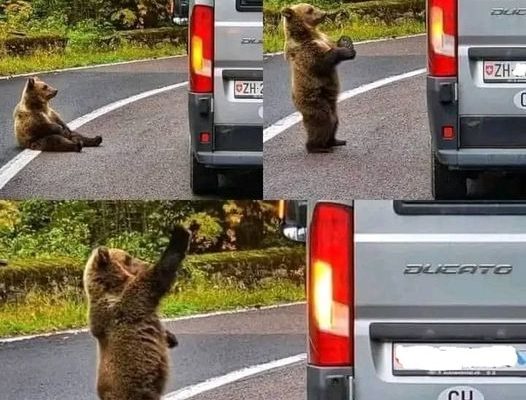Bears and Their Curiosity
Bears, particularly those in North America like black bears and grizzly bears, are known to be exceptionally curious animals. Their brains, relative to body size, are large, enabling them to problem-solve and learn from past experiences. This behavior has been observed in various contexts: bears rummaging through trash cans, investigating tents in campgrounds, and, in this case, attempting to open a car door.
This curiosity is more than just idle exploration; it’s rooted in survival. Bears in the wild depend on their ability to find food, whether by foraging in forests, fishing in rivers, or investigating new objects that might contain something edible. This adaptability has enabled them to survive in a variety of ecosystems, from dense forests to urban environments. Unfortunately, this natural behavior sometimes leads them into human-populated areas, where they can encounter objects like cars, homes, and dumpsters. In many cases, bears are simply drawn to these places by the scent of food or a memory of a past meal, leading them to become bolder in their attempts to secure food.
### Why a Bear Might Try to Open a Car Door
Bears have been documented approaching cars in parks, suburbs, and rural areas, especially when food is left inside. Their sense of smell is incredibly acute, surpassing that of dogs and even most other wildlife. A bear can smell food from over a mile away, which makes any scent within a car an irresistible target. Unfortunately, even seemingly scent-sealed items, like a sandwich in a lunchbox or an empty food wrapper, can catch the attention of a hungry bear.
A car represents both a mystery and an opportunity for a bear. It’s an enclosed space that may contain food, but it also requires manipulation to open. When a bear encounters a car on the side of a road or in a parking lot, it may examine it by sniffing and using its strong, dexterous claws. Bears have learned to recognize that human spaces, like vehicles and campsites, often yield food. This “learned” behavior, however, can lead to problematic interactions with people. Wildlife biologists and park rangers have long noted that once a bear associates humans or human belongings with food, they may continue to seek out these opportunities.
### The Scene: A Bear on the Road
Imagine driving down a quiet road, surrounded by mountains or thick forest, when a large, furry shape appears ahead. At first, it’s a moment of awe—seeing such a magnificent creature in its natural habitat. But as you slow down, the bear notices your car and, instead of retreating, walks toward it. Heart pounding, you lock the doors, wondering what the bear’s intentions are.
In the case of a bear approaching a car, it’s vital to stay inside, keep calm, and make no sudden movements or loud noises. Bears tend to approach cautiously, sniffing around and assessing whether there’s any reward worth the effort. If it’s determined, a bear might paw at the door handle, scratching and tugging in a curious attempt to see what’s inside.
As bears have an innate ability to explore with their claws and noses, they may try to open car doors, especially if they sense an opportunity for food. Onlookers might find the bear’s behavior humorous or even surreal, but the reality is that such actions can lead to potential danger. In some places, there have been multiple reports of bears successfully opening unlocked doors, creating panic for anyone inside the vehicle.
### Bear Behavior: Food Conditioning and Human Interaction
The bear trying to open a car door is likely “food-conditioned,” meaning it has learned that human areas may provide easy access to food. This conditioning happens when bears repeatedly find food in vehicles, camps, or picnic areas, leading them to associate human spaces with food. Over time, a bear that repeatedly engages in this behavior may grow bolder, increasing its willingness to approach cars, campsites, and even residential neighborhoods.
Such food-conditioning behaviors often lead to unfortunate outcomes for the bear. Bears that become too bold or aggressive may have to be relocated or, in some cases, euthanized to protect human safety. This makes responsible food storage crucial in bear country. In areas where bear populations are high, it’s important for people to avoid leaving food or scented items in their cars. Park rangers, especially in national parks with high bear populations, strongly advise visitors to use bear-proof containers and follow strict food storage regulations.
### Safety Tips for Drivers in Bear Country
For those living in or visiting bear-populated regions, it’s essential to understand how to avoid potentially dangerous encounters with bears. Here are a few practical tips:
1. **Keep Doors Locked**: Bears have learned to open unlocked car doors. Locking doors minimizes the chance that a bear will enter.
2. **Avoid Leaving Food in the Car**: Food or scented items like gum, air fresheners, and cosmetics should not be left in the car. Bears can smell these items even if they’re sealed.
3. **Park in Well-Lit Areas**: If possible, park in a well-lit or more populated area, as bears are less likely to approach cars near groups of people.
4. **Make Yourself Known**: If you see a bear approaching your car, speaking in a calm voice or honking the horn gently can sometimes be enough to deter it, though this isn’t always effective.
5. **Stay Inside**: Never try to get out of your car to photograph or interact with a bear. Close all windows and stay calm.
6. **Report Bear Sightings**: Many parks and forested areas have ranger hotlines where you can report bear sightings, which helps rangers keep track of bear activity and warn other visitors if needed.
### Understanding Coexistence with Bears
Encounters like a bear attempting to open a car door highlight the importance of learning to coexist with wildlife. Bears are an integral part of many ecosystems, helping to control prey populations and disperse seeds through their foraging. Yet as human populations expand into previously wild areas, these encounters are becoming more frequent. Wildlife organizations and researchers emphasize that respectful coexistence benefits both humans and bears.
One strategy to promote coexistence is through public education about bear behavior. Parks, nature reserves, and local governments in bear habitats often provide informational resources on how to stay safe while reducing the chances of attracting bears. Techniques like using bear-proof garbage bins, maintaining proper food storage at campsites, and following local guidelines are all important for minimizing encounters. Additionally, conservation groups and some communities are experimenting with deterrents, like electric fencing or scent-based repellents, to keep bears at a safe distance from human areas.
### The Final Thought: Appreciating Bears from a Distance
Seeing a bear trying to open a car door may seem surreal, even funny, but it’s a sobering reminder of the thin line between human spaces and wildlife habitats. Bears are beautiful, powerful animals that deserve respect. While their natural curiosity can lead them into human spaces, it’s ultimately up to us to ensure these interactions are as safe as possible for both humans and bears. Encounters like these are not only a reminder of the beauty of nature but also of our role in preserving and respecting it.
So, the next time you find yourself driving in bear country, remember to lock your doors, keep food stored properly, and enjoy the thrill of being near one of nature’s most incredible creatures—from a safe distance.



